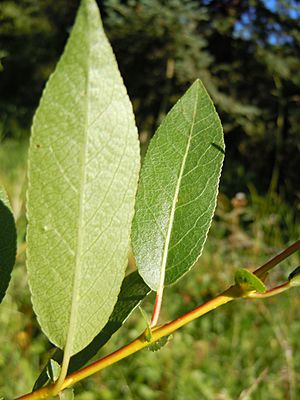Booth's willow facts for kids
Quick facts for kids Booth's willow |
|
|---|---|
 |
|
| Conservation status | |
| Scientific classification | |
| Genus: |
Salix
|
| Species: |
boothii
|
Salix boothii is a type of willow tree or bush. It is often called Booth's willow. You can find it growing naturally in western North America. This includes places like British Columbia and Alberta in Canada, and south into the United States, like California and New Mexico. It loves wet, mountain areas, especially near rivers.
Contents
What Booth's Willow Looks Like
Booth's willow is usually a shrub, which is like a large bush. It can grow up to 6 meters (about 20 feet) tall. When it grows in soil that drains well, it becomes bigger and has more branches. In very wet places, like bogs, it stays smaller and simpler.
Leaves and Flowers
The leaves of Booth's willow are shaped like a spear or an oval. They have a pointed tip and their edges are either smooth or slightly jagged. These leaves can grow up to 10 centimeters (about 4 inches) long when they are fully grown. The top surface of the leaves is shiny. When new leaves first appear, they are covered in soft, white hairs.
The flowers of the willow grow in special clusters called catkins. These catkins appear either before the leaves grow or at the same time. Male catkins can be up to 4 centimeters long, and female catkins can be up to 7 centimeters long. Each male flower has two stamens, which are the parts that produce pollen. Booth's willow usually blooms in May and June.
How Booth's Willow Reproduces
Booth's willow can make new plants in two main ways.
Reproduction by Seeds
One way is through sexual reproduction, using seeds. The flowers produce seeds, which can then grow into new willow plants.
Reproduction by Sprouting
The other way is through vegetative reproduction, which means new plants grow from parts of the parent plant. Booth's willow can sprout new stems from the bottom of its main stem or from its root system. This allows it to create groups of new plants that are actually clones of the original plant. This means they are genetically identical.
Uses of Booth's Willow
Booth's willow is very useful in its natural environment.
Helping with Erosion
This willow often grows in thick groups, forming dense patches. Because of this, it can be used to help control erosion in areas near rivers and streams. These areas are called riparian zones. The willow's roots help to hold the soil in place, stopping it from being washed away.
Surviving Wildfires
Booth's willow is also good at surviving wildfires. If the parts of the plant above the ground burn away, it can grow back relatively easily from its roots and stem base.
See also
 In Spanish: Salix boothii para niños
In Spanish: Salix boothii para niños


